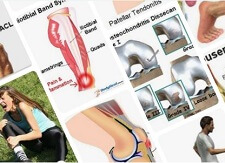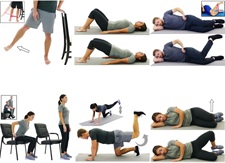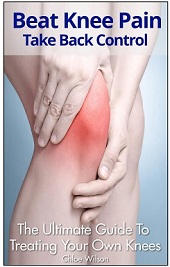- Home
- Hip Pain Diagnosis
Hip Pain Location Diagram
Written By: Chloe Wilson, BSc(Hons) Physiotherapy
Reviewed by: KPE Medical Review Board
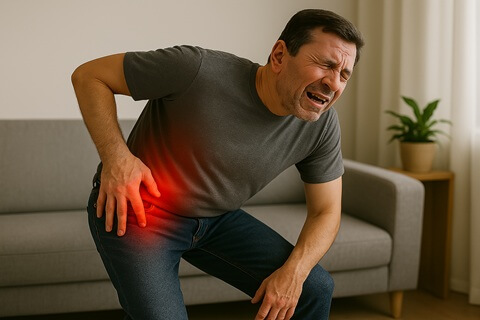
A hip pain location diagram is a really helpful tool to help you work out what is causing pain around your hip, buttocks, thigh or groin area.
There are loads of different structures in and around the hip, from bones to tendons, labrum to bursa.
Injury, irritation, compression or damage to any of these structures can lead to hip pain. The pain may be quite localised or may extend down the thigh towards the knee.
Hip pain diagnosis can be tricky, but knowing what typically causes pain in the different areas of the hip makes it much easier, so we have devised some hip pain diagnosis charts to help you.
Hip Pain Diagnosis Charts
Here you will find three different hip pain location diagrams to help you work out what is causing your pain:
- Front Hip Pain Chart: covers front hip pain, outer hip pain and groin pain
- Posterior Hip Pain Chart: covers pain in the back of the hip and buttocks
- Hip Symptom Checker: covers common hip symptoms and what causes them
We will also look at how to use associated symptoms to work out what causes hip pain with our Hip Symptoms Checker.
Front Hip Pain Location Diagram
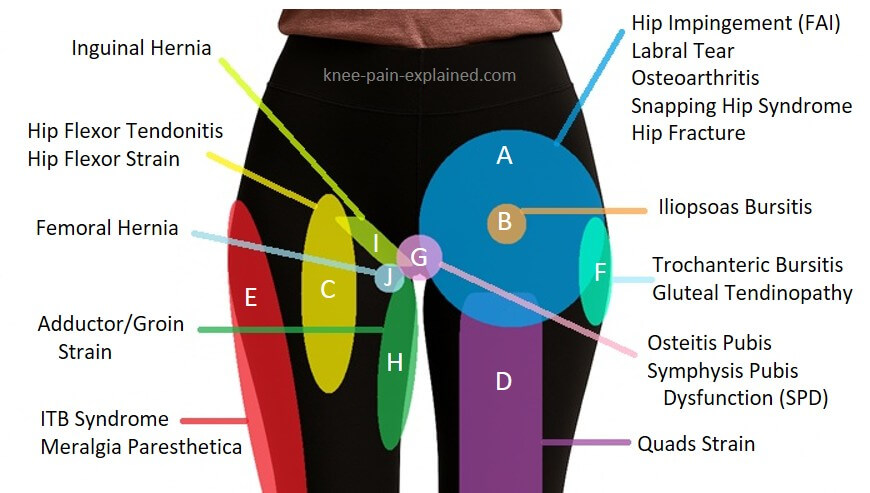
This front hip pain location chart shows the different problems that can develop around the front of the hip and pelvis covering:
- Front Hip Pain: pain around the front of the hip and top of the thigh
- Outer Hip Pain: pain around the outer part of the hip towards the outer buttocks
- Inner Hip Pain: pain around the inner hip, thigh and groin
A. Hip Impingement
Femoroacetabular impingement (FAI) is caused by abnormal bone shape in and around the hip joint. It causes a deep aching pain and stiffness with sharp pain and catching sensations with leg movements. Typically affects young men, athletes and middle aged women. FIND OUT MORE >
Hip Labral Tear
A hip labral tear is when there is damage to the ring of cartilage lining the hip socket. It causes clicking and sharp pain with twisting and pivoting movements and a feeling of instability, limiting physical activity. Symptoms may be felt anywhere around the hip, depending on the location of the tear. FIND OUT MORE >
Hip Osteoarthritis
Osteoarthritis is the most common cause of hip pain and stiffness in people over the age of 50. Gradual wear and tear of the hip cartilage and bone spur formation means the hip cannot move smoothly, resulting in hip pain, stiffness and reduced range of motion. Symptoms are typically worse first thing in the morning and after prolonged activity, and daily activities may be limited.
Snapping Hip Syndrome
With snapping hip syndrome a tendon or nerve flicks over part of the hip bone, causing a popping or snapping sensation when you move your hip. There may or may not be any pain with the snapping and it typically affects athletes and dancers. Hip snapping can occur in different places around the hip causing symptoms at the front, back or sides of the hip. FIND OUT MORE >
B. Iliopsoas Bursitis
With iliopsoas bursitis there is inflammation of the fluid-filled sac that sits between the hip joint bone and the iliopsoas muscle. The bursa helps to reduce friction, but it can get irritated, usually from repetitive hip motion, which causes it to swell. It causes a deep aching, localised pain and tenderness in the front of the hip, directly over the bursa that gets worse with activity. FIND OUT MORE >
C. Hip Flexor Tendonitis
Hip flexor tendonitis is a chronic overuse injury where there is irritation and inflammation of the tendons that bend and lift the hip. It is typically caused by repetitive overuse or sudden increases in activity levels, as well as muscle tightness and weakness. Symptoms include dull aching front hip pain at rest with a sharp or burning pain when lifting the leg e.g. stairs or walking uphill. FIND OUT MORE >
Hip Flexor Strain
A hip flexor strain occurs when one of the hip flexor muscles is overstretched or overloaded and tears. Hip strains usually occur due to sudden acceleration, kicking, pivoting or overstretching. There are three grades of hip strain depending on how many fibres are torn. There is usually a sudden sharp pain at the front of the hip or upper thigh followed by weakness, swelling and bruising. FIND OUT MORE >
D. Quads Strain
A quads strain is when one of the quadriceps muscles tears, again due to overstretching or overloading the muscle. Quads strains typically affect athletes and sports enthusiasts, particularly in middle age. Any activities that involve forceful contractions of the quads muscles e.g. soccer, football and basketball can tear the quads muscles. The pain tends to be further down the thigh than with a hip flexor strain. FIND OUT MORE >
E. Iliotibial Band Syndrome
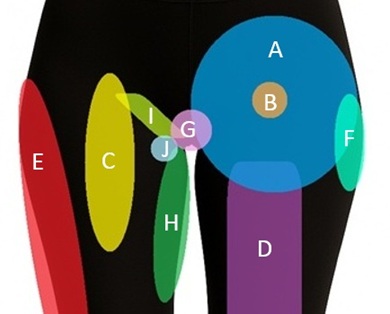
Iliotibial band syndrome (ITBS) is a common cause of outer hip pain that may radiate down the outer thigh. The ITB is a thick band of fibrous tissue that runs between the hip and the knee. Irritation and inflammation of the ITB is common in runners, particularly if you suddenly increase your activity levels or have weakness or tightness in the glutes. FIND OUT MORE >
Meralgia Paresthetica
Meralgia paresthetica is a nerve problem which causes pain, numbness and tingling on the outer thigh. Compression of the lateral femoral cutaneous nerve, from tight clothing, prolonged standing/walking, altered biomechanics or previous hip injuries or surgery causes a burning pain and increased sensitivity in the outer thigh. FIND OUT MORE >
F. Trochanteric Bursitis
Trochanteric bursitis is the most common cause of localised pain on the outside of the hip. Inflammation of the trochanteric bursa which sits directly over the bony prominence on the side of the hip causes a sharp or burning pain on the outer hip, especially when lying on your side or getting up from a chair. FIND OUT MORE >
Gluteal Tendonitis
Gluteal tendonitis is where there is irritation and inflammation in the thick bands that attach the glute muscles to the outer hip bone. It is usually caused by a combination of overuse, muscle imbalance and altered biomechanics and is often associated with trochanteric bursitis. Pain is typically worse when sitting cross-legged, walking uphill or standing on one leg and is often accompanied by weakness. FIND OUT MORE >
G. Osteitis Pubis
Osteitis pubis develops when there is inflammation of the pubic symphysis, the joint at the front of the pelvis. Repetitive stress from activities like running, jumping and quick pivoting irritates and causes micro-trauma at the joint. It causes a dull, aching pain at the front of the pelvis that gets worse with activity, tenderness on palpation and hip clicking. FIND OUT MORE >
Symphysis Pubis Dysfunction
Symphysis pubis dysfunction (SPD) is a common problem in pregnancy, also affecting the pubic symphysis. Increased laxity in the ligaments due to hormonal changes allow excess movement at the front of the pelvis causing a burning or shooting pain in the inner thigh and groin. There may also be a clicking/grinding sensation. FIND OUT MORE >
H. Groin Strain/Adductor Strain
A groin strain is one of the most common causes of inner thigh pain, where there is tearing of one of the adductor muscles. Groin strains are usually caused by sudden overstretching or abrupt movement e.g. quickly changing direction, particularly if you haven’t warmed up properly. It can also develop from chronic overuse, particularly if you have some muscle imbalance. Groin strain typically causes sharp or stabbing groin pain. FIND OUT MORE >
I. Inguinal Hernia
An inguinal hernia occurs when part of the intestine or fatty tissue pushes through a weak spot in the lower abdominal wall, near the groin. It is often caused by straining, heavy lifting, chronic coughing, or a natural weakness in the abdominal muscles. Common symptoms include a visible bulge in the groin, discomfort or pain when bending, coughing, or lifting. The bulge may reduce when lying down and can be more noticeable after activity.
J. Femoral Hernia
A femoral hernia happens when tissue pushes through the femoral canal, a small passage near the groin, just below the inguinal ligament. It is more common in women and can be triggered by straining, pregnancy, or chronic constipation. Symptoms include a lump in the upper thigh or groin area, which may cause discomfort, especially when standing or lifting. Though often small, femoral hernias carry a higher risk of complications and may require prompt medical attention.
Posterior Hip Pain Location Diagram
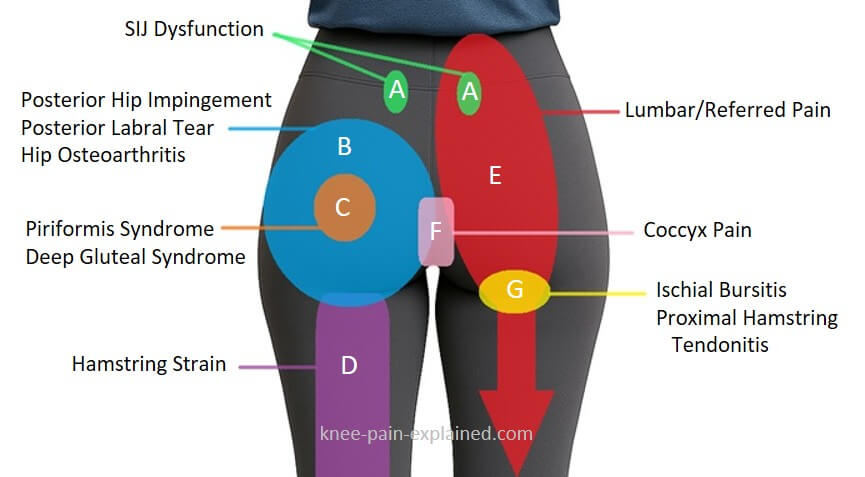
Our next hip pain diagnosis chart focuses on things that cause pain around the back of the hip and in the buttocks as well as down the back of the leg. There is some overlap with the front hip pain map as some conditions refer pain down the sides of the hip and leg.
A. SIJ Dysfunction
Sacroiliac joint (SIJ) dysfunction occurs when the joints connecting the spine to the pelvis become inflamed or move abnormally. It can be caused by trauma, pregnancy, arthritis, or repetitive stress. Symptoms typically include localised lower back or buttock pain, worsening with prolonged standing, climbing stairs or rolling over in bed. SIJ pain is usually one-sided and may feel sharp or achy.
B. Posterior Hip Impingement
Posterior hip impingement occurs when there is abnormal contact between the back of the femoral head and the hip socket, often due to bone spurs or structural abnormalities. Symptoms include deep pain at the back of the hip or buttock, with a catching or pinching sensation during movement. FIND OUT MORE >
Posterior Labral Tear
A posterior labral tear is a tear in the cartilage at the back of the hip socket that helps stabilize the hip joint. It can result from trauma, repetitive twisting motions, or hip impingement. Symptoms include deep buttock or hip pain, often with clicking, locking, or a feeling of instability. FIND OUT MORE >
C. Piriformis Syndrome
Piriformis syndrome is a condition where the triangular muscle in the buttock irritates or compresses the sciatic nerve. It is often caused by muscle tightness, repetitive overuse or trauma. Symptoms of piriformis syndrome include deep buttock pain and tenderness with burning or tingling that may radiate down the back of the leg, similar to sciatica.
Deep Gluteal Syndrome
Deep gluteal syndrome is a broader category encompassing various causes of sciatic nerve entrapment in the buttocks e.g. from fibrous bands, blood vessels and hamstring injuries. It causes deep buttock pain which may radiate down the back of the leg and thigh, often accompanied by a burning or shooting pain and numbness.
D. Hamstring Strain
A hamstring strain is when there is a tear in one of the hamstring muscles, usually due to sudden overstretching or overloading of the muscle. Sprinting, suddenly accelerating, changing direction or overstretching when kicking are common causes of hamstring strains, particularly if the muscle is tight. The maybe a sudden sharp pain at the time of injury followed by bruising, tenderness and weakness. FIND OUT MORE >
E. Lumbar/Referred Pain
Pain in the back of the hip can also originate from a spinal problem, such as spinal stenosis or a herniated disc and is often referred to as lumbar radiculopathy. Pain may be felt in the buttocks and extend down the back of the leg, in some cases all the way to the foot. There may or may not be any back pain, even if the problem originates in the spine. Tingling, numbness and shooting or burning pain is common with referred pain from the back. FIND OUT MORE >
F. Coccyx Pain
Right in the middle of the posterior hip pain diagnosis chart is the coccyx. Coccyx pain, or coccydynia, is pain at the base of the spine where the tailbone (coccyx) is located. It is often caused by trauma from a fall, prolonged sitting on hard surfaces, childbirth, or repetitive strain. Symptoms include localized tenderness, aching, or sharp pain when sitting, rising from a chair, or leaning back. The pain may be persistent or triggered by pressure on the tailbone.
G. Ischial Bursitis
Ischial bursitis is caused by inflammation of the fluid-filled sac that sits between the sitting bones and the gluteus maximus tendon. It is usually caused by repetitive prolonged sitting and activities involving repetitive hip movements e.g. cycling and rowing. Common symptoms include pain directly under the sitting bones and tenderness that gets worse with sitting or hip movement. Ischial bursitis pain often wakes people at night. FIND OUT MORE >
Proximal Hamstring Tendonitis
Proximal hamstring tendonitis is inflammation or irritation of the hamstring tendons where they attach to the sitting bone (ischial tuberosity). It is commonly caused by overuse, especially from activities like squatting or sprinting. Symptoms include a deep ache or sharp pain in the lower buttock, often worsened by sitting, bending forward, or stretching the hamstrings. The area may feel stiff in the morning or after periods of inactivity. FIND OUT MORE >
Hip Pain Symptom Checker
There are many things that can cause pain in and around the hip and hip pain diagnosis can be confusing. So as well as looking at a hip pain location diagram, it can also be helpful to think about associated symptoms.
This hip pain symptoms checker can help you work out what is going on:
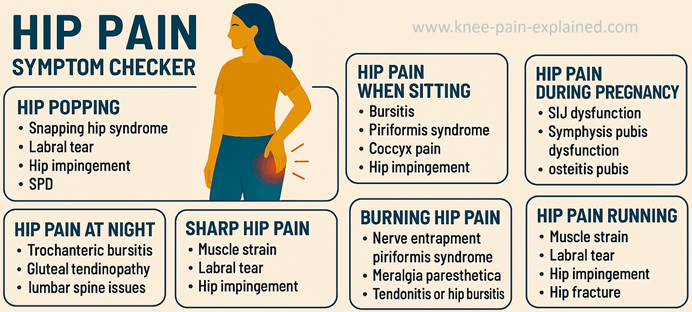
Hip Popping: if there is a popping, clicking or snapping noise or sensation in the hip when you move, it could be from snapping hip syndrome, a labral tear, hip impingement, SPD, osteitis pubis, SIJ dysfunction or hip arthritis.
Hip Pain At Night: hip pain during sleep may be from trochanteric bursitis, gluteal tendinopathy, or lumbar spine issues.
Hip Pain During Pregnancy: the most common type of hip pain in pregnancy is pelvic girdle pain which encompasses SIJ dysfunction at the back of the hip and symphysis pubis dysfunction or osteitis pubis at the front.
Hip Pain When Sitting: Pain in the back of the hip or buttocks when sitting is usually caused by ischial bursitis, piriformis syndrome or coccyx pain. Pain in the front of the hip when sitting may be from arthritis, hip impingement or iliopsoas bursitis.
Hip Pain Running: Front hip pain running may be caused by a hip flexor strain, hip flexor tendonitis, hip impingement or a labral tear. Outer hip pain running may be due to trochanteric bursitis, ITB syndrome or gluteal tendinopathy. Inner hip pain running is usually due to a groin strain or occasionally osteitis pubis.
Burning Hip Pain: A burning sensation in the hip or thigh may be caused by nerve entrapment from a problem in the back, piriformis syndrome or meralgia paresthetica. It may also be due to tendon irritation such as hip flexor tendonitis or hip bursitis.
Sharp Hip Pain: a sudden sharp pain in the hip is usually due to an injury such as a groin strain (inner), hip flexor strain (front), hamstring strain (back) or quads strain (thigh). An ongoing sharp, catching or pinching pain in the hip may be due to a labral tear, femoroacetabular impingement, hip fracture, SIJ dysfunction or hip bursitis.
Hip Stiffness: stiffness or reduced movement in the hip may be due to osteoarthritis, hip bursitis, labral tear, hip impingement, snapping hip syndrome, osteitis pubis or muscle tightness.
Hip & Lower Back Pain: pain in the hip and lower back may be due to a back problem such as stenosis or disc pathology, SIJ dysfunction, coccydynia or muscle tightness.
Hip Pain Location Diagram Summary
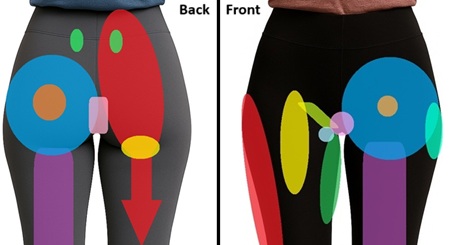
Hopefully you have found the hip pain location diagram charts helpful for working out what is causing your hip pain.
You can find out loads more about each condition, including the common causes, symptoms, diagnosis and best treatment options by looking at the relevant article.
If you want to look at a specific area in a bit more depth than is on the hip pain location charts, choose from the following:
And please remember, the hip pain location diagram and charts are not intended to be a substitute for medical advice. And new incidence of hip pain should be reviewed by a doctor. If your pain is further down your leg, check out our knee pain diagnosis charts. You may also be interested in the following articles:
Related Articles
Hip Pain At Night
October 2nd, 2025
Knee Pain Diagnosis
March 27, 2025
Hip Strengthening
September 24, 2025
Last Updated: November 4th, 2025
Next Review Due: November 4th 2027

